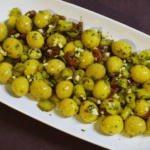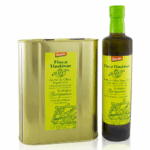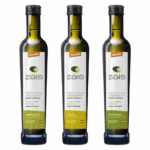
EL RENACIMIENTO DEL ACEITE DE OLIVA VIRGEN EXTRA
La producción y el consumo de aceite de oliva en España han experimentado una auténtica revolución en las últimas décadas
El renacimiento del aceite de oliva virgen extra
La recuperación de un producto casi olvidado, los aceites de calidad virgen extra, y la revalorización de nuestra rica y diversa tradición oleícola, son algunos de sus principales efectos.

A comienzos de los años ochenta del siglo pasado, los aceites de oliva, que hoy llamamos virgen extra, estaba prácticamente ausentes de los lineales de venta y los pocos que podía encontrarse eran generalmente de calidad bastante mediocre.
El mercado español estaba dominado por una segunda calidad, la que se denomina simplemente “aceite de oliva”, una combinación de aceite de oliva refinado, prácticamente insípido, al que se añaden porcentajes variables de aceite virgen para reconstruir su aroma y sabor.
El aceite de oliva es un buen producto, sin duda, y superior a los aceites refinados de semillas, pero que no goza de la condición de ser un zumo natural de aceitunas, con todo el aroma y sabor de la fruta de la que procede, como el aceite virgen extra.
El proceso industrial de la refinación fue descubierto a principios del siglo XX con el objeto de hacer comestibles los aceites de semillas extraídos mediante disolventes. Su aplicación a los aceites de oliva vírgenes de mala calidad, los llamados aceites “lampantes”, tuvo un enorme impacto. El gran tortosino Daniel Mangrané Escardó lo explicaba de este modo en su obra “Los Aceites de Oliva de España”, publicada en 1961.
“La posibilidad de convertir los aceites malos (lampantes) en aceites perfectamente comestibles dio lugar a que se tuviera cada vez menos cuidado en su obtención. Poco a poco, la producción de aceites finos (hoy llamados virgen extra), cuidadosamente obtenidos hasta entonces en determinadas comarcas, fue descendiendo.
Paulatinamente, el gran público se iba acostumbrando al aceite refinado siempre muy superior a los aceites defectuosos que hasta entonces solía consumir y prácticamente llegaron a desaparecer del consumo los verdaderos aceites finos de oliva. El mercado llegó a olvidar su existencia y hasta se puede decir que la desconoce desde entonces”.
Afortunadamente, al compás del desarrollo general del país, el sector oleícola español supo afrontar, en los últimos decenios, un profundo proceso de renovación gracias al cual la producción de aceites vírgenes sin defectos, de calidad extra por tanto, se fue incrementando de forma paulatina.
Al tiempo, los consumidores fueron también redescubriendo y recuperando el gusto por los aceites vírgenes extra, que hoy pueden representar aproximadamente algo más del 30 por ciento del consumo total de aceites de oliva en España.
La confusión entre los diversos tipos, “virgen”, “virgen extra”, “aceite de oliva” es todavía un freno para el desarrollo del mercado pues muchos usuarios no saben bien como diferenciarlos, seleccionarlos y disfrutarlos.
La calidad gustativa de los aceite vírgenes extra no ha cesado de mejorar en España. Hoy día, los avanzados sistemas de cultivo, permiten obtener frutos casi perfectos que se recolectan tempranamente, en el momento óptimo de maduración, cuando el aceite contenido en su interior, ha alcanzado su mayor riqueza de aromas y sabores.
Al esmero y cuidado en el cultivo y recolección de la fruta se une el empleo de la mejor tecnología de extracción, que se adapta a las características de cada variedad de aceituna y a su grado de maduración, para conseguir que el aceite exprimido preserve toda la riqueza de matices que tiene en su capsula original.
El interés por el diseño ha alcanzado también a los aceites V.E., que se presentan, cada vez con mayor frecuencia, en originales envases de lata, o cristal oscurecido para protegerlos del la luz. La comercialización del aceite va siguiendo la estela del vino.

España es el primer productor mundial, muchas zonas reúnen excelentes condiciones para le cultivo del olivo. Andalucía se ha consolidado, en todo caso, como la región olivarera más importante, seguida de Castilla-La Mancha, Extremadura y Cataluña. En Aragón, Valencia, Murcia, Madrid, Baleares, Navarra o la Rioja el cultivo y la elaboración experimentan también un importante desarrollo.
Junto a las numerosas variedades autóctonas, se comienzan a cultivar en España aceitunas traídas desde otros rincones del Mediterráneo, como la griega Koroneiki y la popular Frantoio, de la Toscana, que contribuirán a ampliar la gran diversidad que existe ya en el mercado
Otra muestra del dinamismo del sector son las nuevas denominaciones de origen reconocidas por la Unión Europea, una buena herramienta para que los aceites de oliva de determinadas comarcas de gran tradición, conserven sus peculiaridades propias y puedan ser reconocidos por los consumidores. Por el momento, su reconocimiento es muy bajo, en términos generales, por lo que seria deseable un mayor esfuerzo promocional.
Finalmente, los aceites virgen extra han irrumpido con fuerza en la cocina de vanguardia, donde son objeto de creativos maridajes y trasformaciones insólitas; en las manos de Ferrán Adría, Dani García, Paco Roncero y muchos otros, adquieren nuevas y originales presentaciones y texturas y se convierte en el elemento central de innovadoras recetas.
Autor: Santiago Botas
Sigue informándote en Oliva Oliva







No Comments